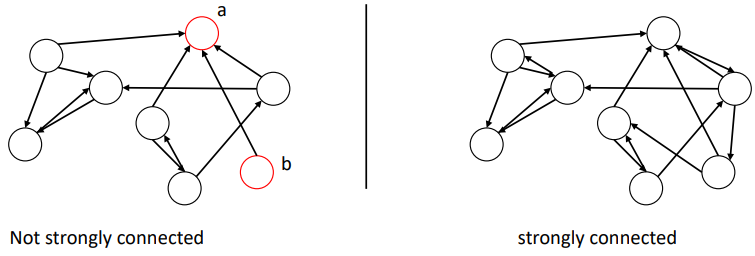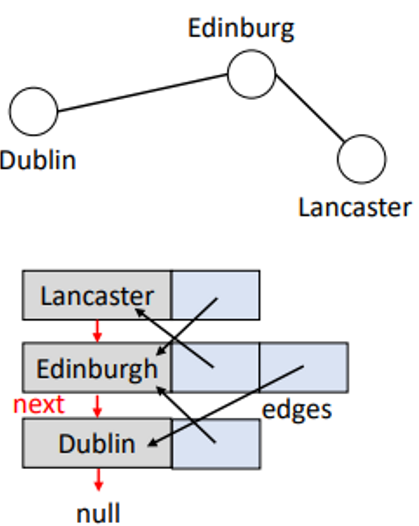Graphs
1/39
There's no tags or description
Looks like no tags are added yet.
Name | Mastery | Learn | Test | Matching | Spaced |
|---|
No study sessions yet.
40 Terms
Graph
set of nodes (or vertices) and edges (or arcs/links)
Simple Graph
no self-loops
Labels
values associated to nodes and edges
can be integers, strings etc
natural setting:
integers for edges (weights)
names for nodes (identifiers)
Undirected Edges
can be traversed in both directions
Directed Edges
can only be traversed in the indicated direction
Subgraphs
of some graph 𝐺 is a subset of the nodes and edges of 𝐺
For both undirected and directed graph

Induced Subgraphs
by subset 𝑈 ⊆ 𝑉 if its nodes are U and its edges are all the edges between nodes in 𝑈 within 𝐺
For both undirected and directed graph

Spanning Subgraphs and Trees
of 𝐺 if it is formed from all nodes of 𝑮 and some of the edges of 𝐺

Spanning Tree
spanning subgraph and tree
Minimum Spanning Tree
Spanning tree with minimum total sum of edge weights

Complementary Graphs
Same set of nodes and contains all edges that are not in 𝐺
Create a clique (fully-connected graph) and remove the edges that are in 𝐺

Density
A measure between 0 and 1 that indicates how heavily connected its nodes are

Connectivity
An undirected graph is if there is a path between any two vertices
Directed graph is strongly if we can reach any node from any other
Directed graph is weakly if its undirected version is strongly

Graph ADT
Common set of operations for graphs,
But applicable to many different settings (networking, social media, public transport, artificial intelligence,…)
Basic operations = node and edge additions/removals, and adjacency queries:
void addNode(Node n);
void removeNode(Node n);
void addEdge(Node n, Node m);
void removeEdge(Node n, Node m);
boolean adjacent(Node n, Node m);
Node[] getNeighbours(Node n);Graph Encoding via Lists
where the graph is a list of lists

List-Based Implementation
public class GraphList(Lable> {
GraphNode headNode;
public class GraphNode<Lable> {
Label id;
LinkedHashSet<GraphNode> edges;
GraphNode next;
public GraphNode(Label label) {
this.id = label;
this.edges = new LinkedHashSet<GraphNode>();
}
}
public GraphList() {
}
...
}
Adding Nodes
public void addNode(Label label) {
GraphNode node = new GraphNode(label);
node.next = headNode;
headNode = node;
}Finding Nodes
private GraphNode findNode(Label label) {
GraphNode node = headNode;
while (node != null) {
if (node.id == label) return node;
node = node.next;
}
return null;
}Adding Edges
public void addEdge(Label l1, Label l2) {
GraphNode node1 = findNode(l1);
GraphNode node2 = findNode(l2);
if (node1 != null && node2 != null) {
node1.edges.add(node2);
node2.edges.add(node1);
}
}Removing Edges
public void removeEdge(Label l1, Label l2) {
GraphNode node1 = findNode(l1);
GraphNode node2 = findNode(l2);
if (node1 != null && node2 != null) {
node1.edges.remove(node2);
node2.edges.remove(node1);
}
}Removing a Node
public void removeNode(Label label) {
GraphNode<Label> node = headNode;
GraphNode<Label> prevNode = null;
while (Node != null) {
if (node.id == label) {
//remove all edges
for (GraphNode<Label> neighbour: node.edges) {
removeEdge(node.id, neighbour.id);
}
//remove node from the 'list'
if (prevNode != null) prevNode.next = node.next;
else headNode = node.next;
}
prevNode = node;
node = node.next;
}
}Neighbours
public GraphNode[] getNeighbours(Label label) {
GraphNode<Label> node = findNode(label);
GraphNode[] neighbours = node.edges.toArray(new GraphNode[0]);
return neighbours;
}Adjacency
public boolean adjacent(Label l1, Label l2) {
GraphNode n1 = findNode(l1);
GraphNode n2 = findNode(l2);
return n1.adges.contains(n2);
}Displaying the Graph
public void print() {
GraphNode<Label> node = headNode;
while (node != null) {
System.out.print("[ " + node.id + " : ");
for GraphNode<Label> neighbour: node.edges) {
System.out.print(neighbour.id + " ");
}
System.out.println"]");
node = node.next;
}
}![<pre><code class="language-Java">public void print() {
GraphNode<Label> node = headNode;
while (node != null) {
System.out.print("[ " + node.id + " : ");
for GraphNode<Label> neighbour: node.edges) {
System.out.print(neighbour.id + " ");
}
System.out.println"]");
node = node.next;
}
}</code></pre><p></p>](https://knowt-user-attachments.s3.amazonaws.com/992f4370-da51-4adb-b5e7-4502f77c1284.png)
Graph ADT - Memory and Time Complexity
Memory = 𝑂(𝑁 + 𝐸) for graphs with 𝑁 nodes and 𝐸 edges (memory-efficient)
Worst-case time complexity:
Adding node is 𝑂(1)
Removing and finding node is 𝑂(𝑁)
Adding and removing an edge is 𝑂(𝑁)
Adjacency check is 𝑂(𝑁)
Graph Encoding via Matrices
Use a two-dimensional array called adjacency matrix
For row 𝑖𝑖 and column 𝑗 (with 𝑖 ≠ 𝑗), 𝐴[𝑖][𝑗] = 1 if and only if there is an edge between nodes 𝑖 and 𝑗
Adjacency matrix is symmetric for undirected graphs: 𝐴[𝑖][𝑗] = 𝐴[𝑗][𝑖]
![<p>Use a two-dimensional array called adjacency matrix</p><ul><li><p><span>For row </span><span style="font-family: "Cambria Math"">𝑖𝑖</span><span> and column </span><span style="font-family: "Cambria Math"">𝑗</span><span> (with </span><span style="font-family: "Cambria Math"">𝑖</span><span> ≠ </span><span style="font-family: "Cambria Math"">𝑗</span><span>), </span><span style="font-family: "Cambria Math"">𝐴</span><span>[</span><span style="font-family: "Cambria Math"">𝑖</span><span>][</span><span style="font-family: "Cambria Math"">𝑗</span><span>] = 1 if and only if there is an edge between nodes </span><span style="font-family: "Cambria Math"">𝑖</span><span> and </span><span style="font-family: "Cambria Math"">𝑗</span></p></li><li><p><span>Adjacency matrix is symmetric for undirected graphs: </span><span style="font-family: "Cambria Math"">𝐴</span><span>[</span><span style="font-family: "Cambria Math"">𝑖</span><span>][</span><span style="font-family: "Cambria Math"">𝑗</span><span>] = </span><span style="font-family: "Cambria Math"">𝐴</span><span>[</span><span style="font-family: "Cambria Math"">𝑗</span><span>][</span><span style="font-family: "Cambria Math"">𝑖</span><span>]</span></p></li></ul><p></p>](https://knowt-user-attachments.s3.amazonaws.com/f0ae0a2b-0924-4b23-84a0-d44b155001b9.png)
Adjacency Matrices
For an undirected graph, two cells are always modified when we add or remove an edge
The sum value of a row tells us how many edges go out of this node
The sum value of a column tells us how many edges go in this node
For a directed graph, single sell modified when we add/remove a directed edge
Read the 1s in row 𝑖 as: “node 𝑖 has an edge to column X”
Adding a Node - Adjacency Matrix
public class GraphMatrix {
int graph[][];
int size;
public GraphMatrix() { this.size = 0;}
public void addNode() {
size++;
int[][] newGraph = new int[size][size];
for (int i = 0; i < size - 1, i++) {
for (int j = 0; j < size - 1; j++) {
newGraph[i][j] = graph[i][j];
}
}
this.graph = newgraph;
}
...Removing a Node - Adjacency Matrix
public void removeNode(int k) {
if (k <= 0 || k > size)
throw new IllegalArgumentException("Bad Index");
size--;
int[][] newGraph = new int[size[size];
for (int i = 0; i < size; i++) {
for (int j = 0; j < size; j++) {
int ip = (I >= k - 1) ? 1 : 0;
int jp = (j >= k - 1) ? 1 : 0;
newGraph[i][j] = graph[i + ip][j + jp];
}
}
this.graph = newGraph;
}Adding Edges - Adjacency Matrix
public void addEdge(int i, int j){
if (i <= 0 || i > size || j <= 0 || j > size)
throw new IllegalArgumentException("Bad indices.");
graph[i-1][j-1] = 1;
graph[j-1][i-1] = 1;
}Removing Edges - Adjacency Matrix
public void removeEdge(int i, int j){
if (i <= 0 || i > size || j <= 0 || j > size)
throw new IllegalArgumentException("Bad indices.");
graph[i-1][j-1] = 0;
graph[j-1][i-1] = 0;
}Neighbours - Adjacency Matrix
int[] getNeighbors(int i){
if (i <= 0 || i > size)
throw new IllegalArgumentException("Bad indices.");
return graph[i-1];
}Adjacency - Adjacency Matrix
public boolean adjacent(int i, int j){
if (i <= 0 || i > size || j <= 0 || j > size)
throw new IllegalArgumentException("Bad indices.");
return (graph[i-1][j-1] == 1);
}Graph ADT - Memory and Time Complexity
Memory = 𝑂(𝑁²) for graphs with 𝑁 nodes and 𝐸 edges (memory-inefficient)
Worst-case time complexity:
Adding node is 𝑂(𝑁²)
Removing node is 𝑂(𝑁²)
Adding and removing an edge is 𝑂(1)
Adjacency check is 𝑂(1)
Graph Traversals
Say you want to discover whether from a specific (source) node 𝑠:
Another specific node 𝑣 is reachable from 𝑠, and what is the shortest path from 𝑠 to 𝑣
Or which nodes are reachable from 𝑠 within some 𝑘 hops
How do we solve? We traverse the graph using:
Depth-First Search
Breadth-First Search
Etc..
We went over these traversals previously, but only for trees. Now we need to deal with cycles and loops
Depth-First Search (DFS) Traversal
Start at the source, and visit a neighbour (and mark it as visited)
From that neighbour, visit one of its neighbours
Repeat until you hit an already visited node
At which point, you backtrack (i.e., go back), and visit another neighbour instead
Until you go back to the source
DFS Code
import java.util.LinkedList;
import java.util.Queue;
import java.util.Stack;
public class GraphSearch{
boolean[] visitedNodes;
GraphMatrix graph;
int graphSize;
public GraphSearch(GraphMatrix g){
this.graph = g;
this.graphSize = g.graph.length;
this.visitedNodes = new boolean[graphSize];
}
public LinkedList<Integer> DFS_traverse(int source){
Stack<Integer> stack = new Stack<Integer>();
LinkedList<Integer> traversal = new LinkedList<Integer>();
stack.push(source);
visitedNodes[source-1] = true;
while(stack.size() > 0){
int currentVisitedNode = stack.pop();
traversal.add(currentVisitedNode);
for (int i = graphSize-1; i >= 0; i--) {
if (graph.graph[currentVisitedNode-1][i] == 1
&& ! visitedNodes[i]){
visitedNodes[i] = true;
stack.push(i+1);
}
}
}
return traversal;
}
}DFS Recursive Code
public LinkedList<Integer> DFS_traverse_recursive(int source){
LinkedList<Integer> traversal = new LinkedList<Integer>();
visitedNodes[source-1] = true;
return DFS_traverse_recursive_aux(source, traversal);
}
private LinkedList<Integer> DFS_traverse_recursive_aux(int currentNode, LinkedList traversal){
traversal.add(currentNode);
for (int i = 0; i < graphSize; i++) {
if (graph.graph[currentNode-1][i] == 1
&& ! visitedNodes[i]){
visitedNodes[i] = true;
DFS_traverse_recursive_aux(i+1, traversal);
}
}
return traversal;
}Breadth-First Search (BFS) Traversal
Start at the source, and visit all nodes at distance 1, then all nodes at distance 2, …
When done, the traversed edges form a BFS tree
The BFS tree gives the shortest paths from 𝒔 (if no edge weights)
BFS Code
import java.util.LinkedList;
import java.util.Queue;
import java.util.Stack;
public class GraphSearch{
boolean[] visitedNodes;
GraphMatrix graph;
int graphSize;
public GraphSearch(GraphMatrix g){
this.graph = g;
this.graphSize = g.graph.length;
this.visitedNodes = new boolean[graphSize];
}
public LinkedList<Integer> BFS_traverse(int source){
Queue<Integer> queue = new LinkedList<Integer>();
LinkedList<Integer> traversal = new LinkedList<Integer>();
queue.add(source);
traversal.add(source);
visitedNodes[source-1] = true;
while(queue.size() > 0){
int currentVisitedNode = queue.remove();
for (int i = 0; i < graphSize; i++) {
if (graph.graph[currentVisitedNode-1][i] == 1
&& ! visitedNodes[i]){
traversal.add(i+1);
visitedNodes[i] = true;
queue.add(i+1);
}
}
}
return traversal;
}